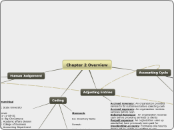Chapter 2 Overview
Accounting Cycle
Ten Steps:
1.) Obtain information from source documents
2.) Analyze transactions
3.) Record transactions in a journal
4.) Post from journal to general ledger
5.) Prepare unadjusted trial balance
6.) Record adjusting entries and post to the general ledger
7.) Prepare adjusted trial balance
8.) Prepare financial statements
9.) Close temporary accounts
10.) Prepare post-closing trial balance
General-purpose financial statements:
-Income Statement
-Statement of changes in shareholder's equity
-Balnace Sheet
-Statement of Cash Flows
Adjusting Entries
Accrued revenues: An organization provides service to its customers before collecting cash
Accrued expenses: An organization receives services before cash
Deferred Revenues: An organization receives cash before providing services to clients
Prepaid expenses: An organization uses up assetsthat have previously been paid for
Uncollectible accounts: Estimates ofa mounts clients will be unable or unwilling to pay
Depreciation: Periodic allocation of an asset's cost to the periods that benefit from its use
Coding
Sequential:
Ex: Purchase order numbers
Format:
101, 102, 103
Block
Ex: Uniform system of accounts for restaurants
Format:
Current Assets- 101, 102, 103
Plan Assets- 202, 206, 208
Currnet Liabilities: 301, 303, 305
Mnemonic
Ex: Inventory items
Format:
DVR: digital video recorder
FSTV: Flat-screened TV
Hierarchical
Ex: State University
Format:
101-11-08-81
101: Big CityCampus
11: Academic affairs division
08: College of Business
81: Accounting Department
Human Judgement
-Designing sourcedocuments
-Recognizing recordable transactions
-Estimating amounts and interpretting account rules
Human judgement very important in analyzing financial statements
